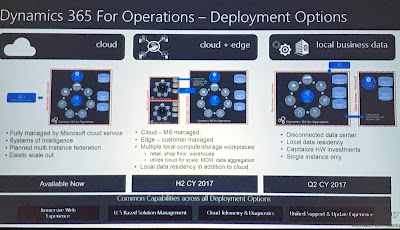During the keynote at D365 Tech and during an in-depth session on deployment options, I was able to get a clearer picture of the offerings that will soon be available. It appears that the cloud version of Dynamics 365 is ready to go as several companies have already implemented this and are moving forward. There is a hybrid model for deployment in addition to the local business data (on-prem) version of Dynamics 365, but neither one is completely ready yet. Keep reading for more info on the deployment options available for users.
 |
| I snapped this photo of a slide shown during the keynote. Great information! |
Cloud
The biggest thing that has been stressed about the cloud deployment option at D365 Tech has been the ease of use, short implementation cycle, and Microsoft's future plans to have updates fully automated. This is supposed to reduce costs in the long run for businesses since they won't have to keep and maintain a datacenter. Cloud environments are easily integrated with other functionality over the cloud such as PowerApps, Power BI, and Flow through the Common Data Service.
Follow Rachel Profitt's blog, www.dynamics365lady.com to learn how to set up the ultimate Dynamics 365 environment. She is currently walking users through, step-by-step, how to set up Azure, LCS, and eventually get to a full Dynamics 365 demo environment with Operations, Sales, and all of the Common Data Service (CDS) offerings.
Dynamics 365 in the cloud is available now.
Cloud + edge
Originally referred to as the hybrid model of Dynamics 365, where some business data is transacted through the cloud and some on-prem (these instances are now called edges). This could be an ideal environment for users with a proprietary process or massive amounts of operations data that they do not want transacted over the cloud.
Edges, or local business data that is transacted in your local datacenter, can be set up multiple ways. They can be set up by site, which seems to be what Microsoft's vision for this is. Possibly good for businesses with sites that have poor internet connectivity. Another way they can be set up is by functional area. An edge can be set up for MRP or Production control.
How does this work?
During the demo of this deployment option, the cloud environment had a blue background/icons and the edge had a green background/icons. Transactions were created in the edge, and within 5 minutes the data was synced to the overall cloud environment. It was neat to see, but heavily dependent on our conference Wi-Fi, which we all know can be troublesome for demos. The Microsoft engineers said data can be synced from edge to cloud, from cloud to edge, or you could keep them completely separate and never sync them if that's your desire. Transactions are separated by a data area ID to avoid overlap and potential issues with number sequences.
This appeared to be a deployment option that still needed some work. There was some promising functionality, but the Microsoft engineers even admitted that this was not a perfect option, but had a lot of potential. Expect it to be released in the second half of 2017.
Local business data
The local business data deployment option is what users are currently calling the on-prem environment. This requires users to have their own datacenter. It was warned that using the local business data option would limit the functionality of the cloud based CDS options such as PowerApps and Power BI, but there seemed to be differing opinions on that since people are actively using Power BI with their on-prem environments now. Even if this is limited, I would expect Microsoft to come up with something for these users to utilize that technology in the future.
This is very close to being released. Expect it after Q2 in 2017 when pricing is announced.
No comments:
Post a Comment